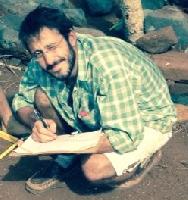Experiences |
PhD Research (2010 to 2013)
— University of French Polynesia
Abstract :
The ubiquity of stone adze blades in archaeological sites and museum collections resulted in their use as “cultural fossils” to draw cultural evolutionary changes in the Polynesian islands. The typological approach proves useful for understanding the archaeological diversity in Oceania. Yet, it lacks efficiency when it comes to shedding light on the technical and economic choices involved in the production processes.
After a discussion of previous knapping experimentations performed in Polynesia, I propose a panel of diagnostic criteria for identifying the use of hard and soft hammerstone in the manufacture of adze blades. Then, I focus on the production of blades from assemblages collected on the North coast of Tubuai Island (Austral Archipelago, French Polynesia). Along with the need to consider the whole manufacturing process and the post-production exchange networks comes the necessity to connect different archaeological assemblages. Geochemical characterisation of the geological sources and artefacts discovered within archaeological contexts were used to settle the favoured framework for understanding the series of production sequences and for identifying the transfer of tools produced within and outside the island. Among the different supply networks identified on the island, I chose to investigate the operational sequences located within two sites: a quarry complex involving several workshops and a coastal dwelling site.
Through the investigation of manufacture, maintenance and exchange processes regarding stone adze blades, I propose a new insight on the economic system in the chiefdoms of central Polynesia. The technical tradition documented on Tubuai is related to the production and transformation of flakes used as blanks for adze blades manufacture. This association of flaking and shaping processes originated in Western Polynesia but was also spread over Eastern Polynesia. The size and the form of these adzes were directly linked to one’s capacity for producing standard-sized blanks and for shaping specific blades forms. Based on the Tubuai collections, I identified a highly standardised production related to specialist knappers’ workshops, as well as a production of heterogeneous forms of small adze blades within a non-specialised dwelling context. Thanks to the analysis of the production processes within the community and the long-distance intercommunity exchanges, I finally discuss the economic role of stone adzes in ancient Polynesian chiefdoms.
Keywords: Prehistory, Archaeology, Ethnohistory, Polynesia, Austral Island, Chiefdom, Stone tools, Lithic technology, Geochemistry, ExchangeTeaching Experiences (2014 to 2017)
— University of French Polynesia
Prehistory of the Pacific (to undergraduate)
Cultural anthropology of Oceania (to undergraduate)
Peopling of the Pacific (to 1st year Master)Collaborative Project (2014 to now)
— Associations Te 'ihi papa no ta'ato'a and Puna Reo Piha'e'ina
Marae Pererau is located in the district of Piha'e'ina in Mo'orea (Society islands, French Polynesia). Its restoration is part of an educational project of the Puna Reo, an association inspired by Maori Kohanga Reo schools that is promoting and teaching tahitian language as well as legends, games and dances to Mo'orea kids.Academic Position (2015)
— LabEx CORAIL
Haere i tai - Ecology of marine exploitation in pre-european Tubuai (Austral Islands, French Polynesia) ».
Le projet Haere i tai, démarré dans le cadre de ce post-doc, est un programme de recherche sur l'exploitation des ressources marines dans l'île de Tubuai (Archipel des Australes) au cours du dernier millénaire.
Les travaux entrepris portent essentiellement sur les vestiges archéologiques découverts au sein du site d'Atiahara (Tupua'i, Archipel des Australes, Polynésoe Française). Afin d'aider à la reconstitution des stratégies de pêche traditionnelles, nous réalisons des enquêtes ethno-archéologiques qui impliquent également la prise en compte des observations ethnographiques et des traditions orales récoltées depuis le début du 20e siècle.Consulting Work (2016)
— SPC - Pacific Community
"Funded by the 10th European Development Fund (EDF), implemented by the Pacific Community (SPC) and steered by French Polynesia, INTEGRE aims at promoting the implementation of integrated coastal zone management (ICZM) in its beneficiary OCTs and in the Pacific region generally."(http://integre.spc.int/en/the-project/the-project).
In the frame of this project, the municipal government of the district of Toahotu and the SCP wished to document and promote natural and cultural environment and history of the Aoma valley. I was part of the project led by Jean-François Butaud (botanist) and carried on a synthesis of the ethno-historical data and oral traditions available on Toahotu district, as well as a detailed survey archaeological remains in the Aoma valley.Academic Position (2017 to 2020)
— Max Planck Institute for the Science of Human History
My research focuses on the evolution of Pacific societies, centering on the relationships between technology, exchange systems and social organisations in Oceania through time. As an archaeologist, I have always incorporated a strong ethno-historical element as well as archaeometric evidences into my research.
My current projects involve the study of the settlement history in Pacific islands and especially the Polynesian diaspora phenomenon, the expression of past social events through a technological approach of material cultures, and interisland interactions through archaeometric evidences such as geochemical fingerprints.Academic Position (2020 to now)
— CNRS (UMR 8068) |

